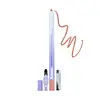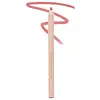What's inside
What's inside
 Key Ingredients
Key Ingredients

 Benefits
Benefits

 Concerns
Concerns

 Ingredients Side-by-side
Ingredients Side-by-side

Trimethylsiloxysilicate
EmollientIsohexadecane
EmollientSynthetic Wax
AbrasiveEthylhexyl Palmitate
EmollientKaolin
AbrasiveCeresin
Emulsion StabilisingMica
Cosmetic ColorantIsododecane
EmollientPolybutene
Vp/Hexadecene Copolymer
Copernicia Cerifera Wax
Sodium Hyaluronate
HumectantEthylene/Propylene Copolymer
AbrasiveCaprylyl Glycol
EmollientGlyceryl Caprylate
EmollientGlucomannan
Skin ConditioningTrihydroxystearin
Skin ConditioningCI 77891
Cosmetic ColorantCI 77491
Cosmetic ColorantCI 77492
Cosmetic ColorantCI 77499
Cosmetic ColorantCI 15850
Cosmetic ColorantTrimethylsiloxysilicate, Isohexadecane, Synthetic Wax, Ethylhexyl Palmitate, Kaolin, Ceresin, Mica, Isododecane, Polybutene, Vp/Hexadecene Copolymer, Copernicia Cerifera Wax, Sodium Hyaluronate, Ethylene/Propylene Copolymer, Caprylyl Glycol, Glyceryl Caprylate, Glucomannan, Trihydroxystearin, CI 77891, CI 77491, CI 77492, CI 77499, CI 15850
Simmondsia Chinensis Seed Oil
EmollientCopernicia Cerifera Cera
EmollientDextrin Isostearate
Skin ConditioningSqualane
EmollientCaprylic/Capric Triglyceride
MaskingDicalcium Phosphate
AbrasiveCandelilla Cera
EmollientCastor Isostearate Succinate
Skin ConditioningMica
Cosmetic ColorantHydrogenated Castor Oil
EmollientCalcium Silicate
AbsorbentTocopherol
AntioxidantCI 77891
Cosmetic ColorantCI 77491
Cosmetic ColorantCI 77492
Cosmetic ColorantCI 77499
Cosmetic ColorantCI 15850
Cosmetic ColorantIngredients Explained
These ingredients are found in both products.
Ingredients higher up in an ingredient list are typically present in a larger amount.
Ci 15850 is the pigment color red. It is an azo dye and created synthetically.
Azo dyes need to be thoroughly purified before use. This allows them to be more stable and longer-lasting.
This ingredient is common in foundations, lipsticks, and blushes. This color is described as brown/orangey red.
It has many secondary names such as Red 6 and Red 7. According to a manufacturer, Red 6 usually contains aluminum.
Learn more about CI 15850Ci 77491 is also hydrated iron III oxide. It's sole purpose is to give a red/pink hue to products.
Iron III oxides are classified as inorganic chemicals for coloring.
Synthetically created Ci 77491 is considered safer than those naturally found. This is because the synthetically created version may contain less impurities. Iron oxides are generally non-toxic and non-allergenic.
Learn more about CI 77491Ci 77492 is also hydrated iron III oxide. It's sole purpose is to give a yellow hue to products.
Iron III oxides are classified as inorganic chemicals for coloring.
Synthetically created Ci 77492 is considered safer than those naturally found. This is because the synthetically created version may contain less impurities. Iron oxides are generally non-toxic and non-allergenic.
Learn more about CI 77492Ci 77499 is also hydrated iron III oxide. It is created from mixing red and black iron oxides. This helps give shades of darkness to a product.
Iron III oxides are classified as inorganic chemicals for coloring.
Ci 77891 is a white pigment from Titanium dioxide. It is naturally found in minerals such as rutile and ilmenite.
It's main function is to add a white color to cosmetics. It can also be mixed with other colors to create different shades.
Ci 77891 is commonly found in sunscreens due to its ability to block UV rays.
Learn more about CI 77891Mica is a naturally occurring mineral used to add shimmer and color in cosmetics. It can also help improve the texture of a product or give it an opaque, white/silver color.
Serecite is the name for very fine but ragged grains of mica.
This ingredient is often coated with metal oxides like titanium dioxide. Trace amounts of heavy metals may be found in mica, but these metals are not harmful in our personal products.
Mica has been used since prehistoric times throughout the world. Ancient Egyptian, Indian, Greek, Roman, Aztec, and Chinese civilizations have used mica.
Learn more about Mica